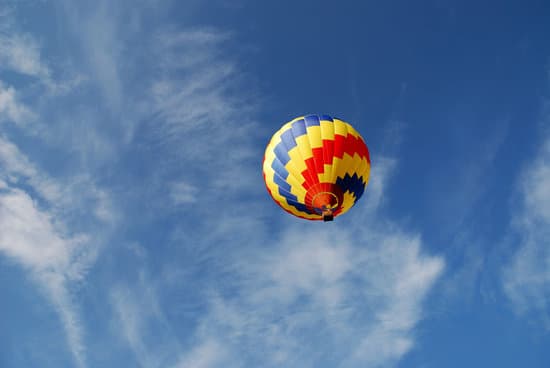Have you always been fascinated by hot air balloons? You can hop onto one of these colorful, dreamy, floating blobs and soar in the air! You will be high up in the sky, far away from the mortal land. How high exactly are we talking about?
A hot air balloon can generally fly about 1,000 to 3,000 feet above the ground! When such flying sacks go above populated regions, they should legally fly above 1,000 ft in the air.
For areas with higher altitudes, they do not usually go beyond 3,000 feet. The highest a hot air balloon has reached is 68,986 ft in the air!
With hot air balloons, you can have an exhilarating or leisure experience. Moreover, you can also break some records while having your adventure!
So, how high can hot air balloons fly? How do they even fly so high in the first place? Why are there limits, and have they ever been surpassed? Read on to find out.
What is the Average Height of Hot Air Balloons?
On average, a hot air balloon flies around 1,000 to 3,000 ft above the ground. It applies both within the United States of America and outside it.
Most of the laws that are referenced later are specific to the USA. However, the average height is pretty much the same in every region across the globe.
Along with a successful hot air balloon ride, safety is paramount to make your adventure memorable. Both largely depend upon the weather conditions, particularly the wind. The average height of 1,000 to 3,000 ft in the air has the most favorable wind conditions.
This height also gives you a spectacular view! Be ready to get your minds blown away!
Most pilots of hot air balloons prefer flying at a lower altitude. It is because the weather conditions are generally more compatible. Additionally, it is much warmer here.
The higher you go, the colder it gets! With every 1,000 ft, you can expect it to get colder by 3 to 4 degrees.
Would you still like to go higher? Well, you are not alone. Many passengers want to see how higher their hot air balloon can go. It is for the view and, of course, the thrill.
Luckily, pilots know exactly how high they can safely go while making sure the passengers are contented.
An Understandable Fear of Heights
Do you find the idea of being about 1,000 – 3,000 feet high in the air quite scary? The fact that one nylon sack holds you up with the help of hot air may not be very helpful either!
There is also a wicker basket that you have to trust to hold you up in the air. So, is it really safe to fly in hot air balloons at a height of more than 1,000 feet?
Well, you have nothing to worry about. Thousands of hot air balloons had a safe flight at such high altitudes! There have only been a very small number of accidents. Moreover, most of these accidents take place below 1,000 feet.
Once you reach cruising altitude, you are safe! It is during the takeoff and landings that accidents, if any, are likely to occur.
When you are high up in the sky, you will not run into something. Additionally, you will be low enough so that the wind conditions are favorable.
Another advantage is that hot air balloons have their path in the air. You do not have to worry about helicopters and airplanes!
In this way, the average height of 1,000 to 3,000 feet makes a safe and comfortable flight. This ideal height not only reassures your safety but also guarantees an enjoyable time!
Did you know that you are more likely to meet with an accident in a motorcycle or car on the land than in hot air balloons that fly high up in the air?
So, 1,000 – 3,000 feet in the air does not sound that bad after all. Wouldn’t you agree? This average altitude of hot air balloons is just right!
How Do They Fly So High?
You now know how high hot air balloons can fly on average. Are you wondering how do they even fly and get up there?
The answer to this is simple, as well as a little complex. You will also find this fascinating! Let’s jump right into it.
Buoyancy
A simple, straightforward answer is that a hot air balloon flies with the rise of hot air. It is as simple as that.
Do you want an answer with more details? We need to get into scientific explanations for that. For this, you need to understand what buoyancy does.
There is a buoyancy law, also known as the Archimedes’ principle. This law applies to any object that is partially or completely submerged in liquid or gas (fluids). Such an object is acted on by the upward force.
The upward force equals the volume of fluids that the object displaces. This force is known as the buoyancy force.
Example
Let’s understand buoyancy better with an example of one tennis ball in the water. Here, the object is the ball, and the fluid is water.
You will find that the ball displaces the water. It does so till the upward force equals to downward force that gravity exerts. When this happens, the ball begins to float!
Does this happen when you place one lead ball of the same size in the water? You know that it would instead sink. Why does it sink?
When both the lead ball and the tennis ball submerge, they displace the same quantity of water. The same buoyant force acts on both the balls. However, the difference lies in the weight of both balls.
A lead ball weighs more than a tennis ball. The lead ball will have a greater force downwards. It causes the lead ball to sink. The lightweight tennis ball, on the other hand, floats in the water. It is Archimedes’ principle.
Buoyancy and Hot Air Balloons
Now that you understand buoyancy let’s find out how it applies to a hot air balloon.
A fluid can be in the state of liquid or gas. All the oxygen and air that you are surrounded by is in the state of a gas. It qualifies as fluid.
The envelope of the hot air balloon fills up with hot air. This hot air is less dense and much lighter in comparison to the outside air. So, the envelope starts rising. It happens because the buoyant force is more than the gravity’s downward force.
The downward force that works on the hot air balloon will never change. However, when the inside air starts heating, the buoyant force rises. The greater the buoyant force, the higher and faster your hot air balloon rises!
By filling up with hot air, hot air balloons start flying. The pilots keep shooting flames in the envelope. It keeps the inside air heated. In this way, your hot air balloon rises high up in the air!
If you want your hot air balloon to go higher, the envelope’s air must be warmer. When you wish to land, you must let the air escape.
There is, however, more physics involved than this. We have, however, covered the necessary stuff.
You now know how and why hot air balloons fly so high into the air!
Are There Any Limits?
Yes, there are some limits for the flight of a hot air balloon. What exactly are the limits? There are some different ways that this question can be answered.
One of these is by addressing some legal limitations. The other ways are the limits that the natural laws and physics laws impose.
There are also the limitations of how high or how low you can go. So, there are plenty of ways to answer the question at hand!
Let’s now look into all these limits. We’ll start with the limitations that we enforce on ourselves.
Man-Made Limits
We will only look into the limits and laws that apply to the USA in this section. Other countries have a diverse set of laws for hot air balloons. It would be impossible to address the laws of countries all across the globe in this post.
There are a high number of laws in the USA too. Our focus will only be upon one limit that answers two of our questions.
In the USA, hot air balloons should fly at a minimum of 1,000 feet. Above the highest obstacles, about 2,000 horizontal ft while flying above populated regions.
This law is similar to the law of Australia. According to it, all hot air balloons should fly 1,000 ft over the ground while traveling above any populated region. The law of the USA is slightly more precautious.
Such laws are some examples of the limits that are man-made. They state how high or low hot air balloons can go.
Limits of Nature
Nature also has a few limits set for hot air balloons. These are much more binding in comparison to the man-made ones. Additionally, the consequences when you ignore them can be much more severe.
Did you ever wonder why many hot air balloons do not go above 3,000 feet? It is because, in a few countries, there are legal limits.
For most other balloonists, it is because of the unpredictability of the air at such heights.
The winds are very unpredictable at this level. Moreover, they are much stronger. It is due to the convection currents that the changes among the air temperatures create.
Another reason is that the higher your hot air balloon goes, the colder the temperature turns. Additionally, if you go above 8,000 ft, the air begins to get thinner. A slow elevation could also lead to elevation sickness.
It is for such natural limits that many hot air balloonists choose to remain closer to the land while flying.
If you do wish to fly higher, you have to use special equipment. It is necessary for a successful and safe hot air balloon ride.
The Highest Hot Air Balloon Flight Ever
Many hot air balloonists go about 1,000 to 3,000 feet high in the air. There are, however, some who went higher than this. When we say higher, we mean so much higher!
They do not, of course, fly in any regular hot air balloons. They collaborate with engineers and scientists to design the best equipment. Much research and studies later, they come up with the best ways to reach higher altitudes.
Such adventures are certainly an exception to the rules.
One balloonist achieved the feat of soaring much higher than any other. An Indian aviator and businessman, Vijaypat Singhania, flew a hot air balloon up to 68,986 feet!
It is straight-up more than 13 miles! Do you think this record cannot get more impressive than this? Well, wait for it. Singhania was at the age of 67 years when he achieved this record in 2005! Truly an incredible feat!
Are you wondering how Singhania pulled off this marvelous record?
The Highest Record
Singhania has always been an adventurous man throughout his life. He had a desire to fly above 70,000 feet up in the air in one hot air balloon. He was already a successful aviator and businessman. No one had any doubt that he would accomplish this goal of his.
While Singhania may not have reached his goal, we must commend him as he came so close to it. Additionally, with this feat, he broke the previously held record of Per Lindstrand. This hot air balloon flew a little below 65,000 ft in elevation.
The hot air balloon that Singhania used was very expensive. Unfortunately, we do not know how much did it exactly cost.
We do, however, know that it was designed to withstand extreme altitudes. It was about 160 feet in height and around 44 tons in weight upon being fully inflated.
As part of his preparations, Singhania remained in one pressurized cabin. He stayed there for only below five hours to achieve this impressive record.
His flight took off from Bombay and landed about 150 miles in the south of a tiny village. Many local villagers and reporters were enthusiastically awaiting his arrival. His record-breaking feat was witnessed by this excited crowd.
The initial reports stated that the height was much higher. The later verification states that it was indeed 68,986 feet. This exact height has been verified by the sealed equipment that was on board.
Singhania also holds many other aviation awards and records! This singular achievement of his with the hot air balloon has been recognized by countries across the globe. His fortitude and bravery are truly remarkable!
What Is Next on the Horizon?
Did anyone come close to breaking Singhania’s record? In the current times, it looks like Singhania’s record is not very secure!
A Russian explorer, Fedor Konyukhov, is gearing up to set an all-new record. This Russian explorer holds several world records in different fields. He is presently teaming up with Cameron Balloons while eyeing a new record in highest flight for hot air balloons!
Who is Fedor Konyukhov?
Fedor Konyukhov aims to fly 114,800 feet in a hot air balloon! He has had this dream right from his childhood. Clearly, Konyukhov is not only looking to break the present record but also to smash it!
He is regarded to be a great explorer in our times by many. It would be another one in his long list of achievements.
Konyukhov has achieved the feat of being the fastest around the world in the hot air balloon. Additionally, he was the second pilot who circumnavigated the globe in a hot air balloon. He has also climbed the highest peak on every continent!
He is, moreover, a priest of the Orthodox Catholic Church in Ukraine, a noted artist, and a former member of the Soviet Navy.
So, if anyone can fly above 100,000 feet in a hot air balloon, Fedor Konyukhov seems to fit the bill!
What Lies Next?
Cameroon Balloons stated in October 2018 that the balloon for Fedor Konyukhov is halfway done. It is going to be the biggest hot air balloon!
Everything has to be precise because to accomplish his goal, Konyukhov must fly in the exosphere. His age is presently 67, just like when Singhania set his record.
So, hold on tight with your eyes wide open! A new record in hot air ballooning may be much closer to the horizon.
Final Thoughts
Hot air balloons can definitely make your day. An exciting adventure in a colorful balloon, high up in the air? – yes, please!
Hot air balloons can go as high as 1,000 to 3,000 feet in the air on average. They guarantee a spectacular view as well as a thrilling experience!
Just keep in mind to follow the legal limits before hopping on to one, and you are all set for your adventure!






